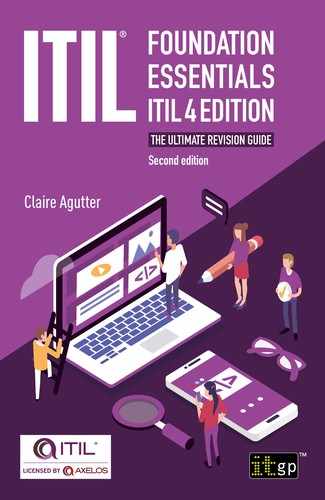CHAPTER 3: ALL ABOUT SERVICES
This chapter defines:
•Products and services
•Utility
•Warranty
•Output
•Outcome
•Risk
Products and services
The services an organisation provides are based on one or more products. Products are created from configurations of the resources an organisation has access to. Resources include:
•People
•Information
•Technology
•Value streams
•Processes
•Suppliers
•Partners
“A service is a means of enabling value co-creation, by facilitating outcomes that customers want to achieve, without the customer having to manage specific costs and risks.”
“A product is a configuration of an organization’s resources designed to offer value for a consumer.”
Service providers need to consider the following areas to assess whether or not they are delivering something that will support value co-creation:
•Cost
•Risk
•Outputs
•Outcomes
•Utility
•Warranty
Outputs and outcomes
A service provider organisation produces outputs, which help its consumers to achieve their desired outcomes. This is where co-creation is important; without input or activity from the consumer, no value is created.
“An output is a tangible or intangible deliverable of an activity.”
“An outcome is a result for a stakeholder enabled by one or more outputs.”
Value is created when a service has more positive than negative effects. For example, it might cost a consumer money to pay for an externally provided email service, but it reduces the amount of money they spend on internal resources and transfers the risks associated with hardware failure to another organisation. Figure 1 shows this balance between the costs and risks removed or introduced by a service.1

Figure 1: Achieving value: outcomes, costs and risks
The service provider needs to understand the costs of service provision to make sure they are within set budgetary constraints and the organisation is profitable, where relevant. For example, public sector organisations might be required to meet budget targets rather than generate a profit.
Cost and risk
Cost is “the amount of money spent on a specific activity or resource.”
Risk is “a possible event that could cause harm or loss or make it difficult to achieve objectives. Risk can also be defined as uncertainty of outcome and can be used in the context of measuring the probability of positive outcomes as well as negative outcomes.”
Service providers manage the detail of risk on behalf of the consumer. The consumer participates in risk reduction by helping to define the service, and what it needs to do.
Utility and warranty
Service providers assess the utility and warranty of a service to check it will create value.
•Utility describes what the service does (fit for purpose)
•Warranty describes how the service performs (fit for use)
“Utility is the functionality offered by a product or service to meet a particular need.” This describes what the service does, and whether it is fit for purpose. A service can provide utility by removing constraints from the consumer or supporting their performance, or both.
“Warranty is the assurance that a product or service will meet agreed requirements.” Warranty describes how a service performs and whether it is fit for use. Warranty covers areas like availability, capacity, security and continuity; the service must meet the levels required by the consumer.
Cost, risk, utility and warranty all provide a picture of a service’s viability.
1 ITIL® Foundation, ITIL 4 edition, figure 2.2.
